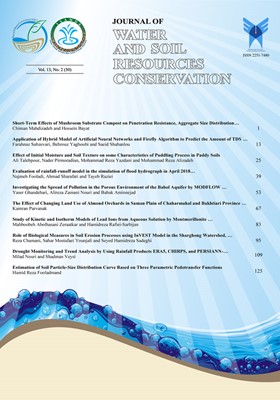-
-
List of Articles
-
Open Access Article
1 - Short-Term Effects of Mushroom Substrate Compost on Penetration Resistance, Aggregate Size Distribution and Their Stability in Soils with Different Textures
Chiman Mahdizadeh Hossein Bayat -
Open Access Article
2 - Application of Hybrid Model of Artificial Neural Networks and Firefly Algorithm to Predict the Amount of TDS in River Water
Farahnaz Sabzevari Behrouz Yaghoubi Saeid Shabanlou -
Open Access Article
3 - Effect of Initial Moisture and Soil Texture on some Characteristics of Puddling Process in Paddy Soils
Ali Talebpour Nader Pirmoradian Mohammad Reza Yazdani Mohammad Reza Alizadeh -
Open Access Article
4 - Evaluation of Rainfall-Runoff Model in the Simulation of Flood Hydrograph in April 2018; a Case Study of Karkheh Basin
Najmeh Fooladi Ahmad Sharafati Tayeb Raziei -
Open Access Article
5 - Investigating the Spread of Pollution in the Porous Environment of the Babol Aquifer by MODFLOW and MODPATH Models
Yaser Ghandehari Alireza Zamani Nouri Babak Aminnejad -
Open Access Article
6 - The Effect of Changing Land Use of Almond Orchards in Saman Plain of Chaharmahal and Bakhtiari Province to Agricultural Lands on Some Physical and Chemical Indicators of Soil Quality
Kkamran Parvanak -
Open Access Article
7 - Study of Kinetic and Isotherm Models of Lead Ions from Aqueous Solution by Montmorillonite and Montmorillonite Modified with HDTMA-Br
Mahboobeh Abolhasani Zeraatkar Hamidreza Rafiei-Sarbijan -
Open Access Article
8 - Role of Biological Measures in Soil Erosion Processes using InVEST Model in the Sharghong Watershed, South Khorasan, Iran
Reza Chamani Sahar Mostafaei Younjali Seyed Hamidreza Sadeghi -
Open Access Article
9 - Drought Monitoring and Trend Analysis by Using Rainfall Products ERA5, CHIRPS, and PERSIANN-CDR Rainfall Products in Iran
Milad Nouri Shadman Veysi -
Open Access Article
10 - Estimation of Soil Particle-Size Distribution Curve Based on Three Parametric Pedotransfer Functions
Hamid Reza Fooladmand
-
The rights to this website are owned by the Raimag Press Management System.
Copyright © 2021-2025







